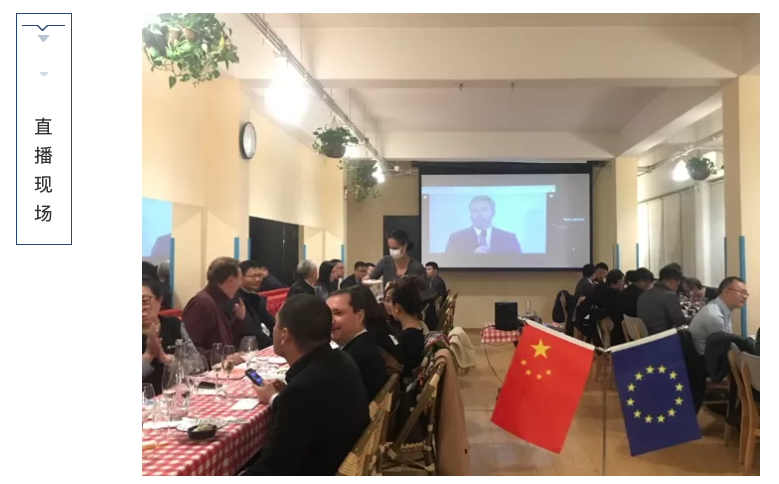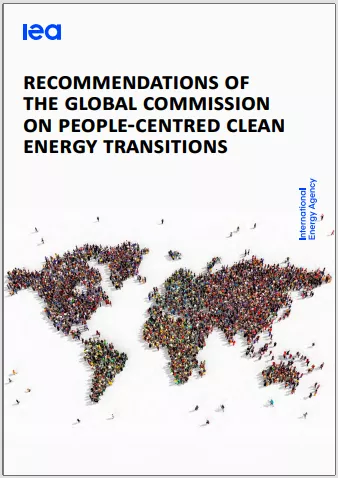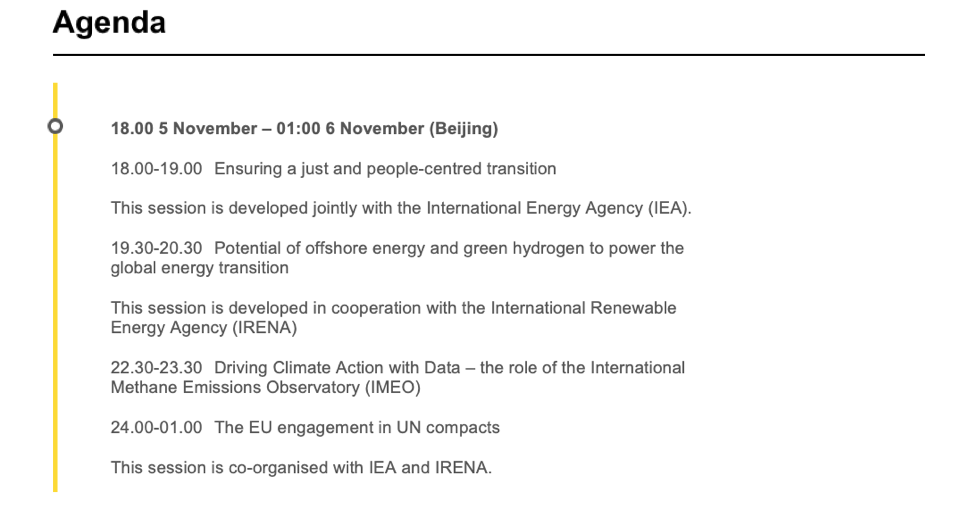
A live streamed event brought energy players together in Beijing to follow presentations given at November’s COP26 summit in Scotland. Daisy Chi and Helena Uhde celebrates the initiative, and offers a round up of key points made by energy representatives from around the world.
On 5 November 2021, Beijing was the venue for a COP26 side event, allowing policy makers, CEOs and local politicians to discuss global initiatives to effect the energy transition. The occasion coincided with EU Energy Day, and offered media and industry experts to meet for a live stream of the Climate Change Conference (COP26) in Glasgow. COP26 is an international event organised by the European Union, together with the International Energy Agency (IEA) and the International Renewable Energy Agency (IRENA). Its aim is to highlight the EU’s leading role in the energy transition, engage international players in the global green recovery and energy transition, and offer an opportunity to share best practice.
The EU-China Energy Cooperation Platform (ECECP) organised the EU Energy Day live streaming event in recognition of the similar challenges faced by the EU and China in the energy transition and in tackling climate change. Simultaneous interpretation ensured that the high-level meetings at COP26 were easy for the Chinese audience to follow. Representatives from the EU delegation in Beijing, the National Energy Administration, as well as energy industry experts and academics from institutions such as China Electricity Council, State Grid Energy Research Institute, as well as the China National Institute of Standardisation, attended the event in-person, joined by 16 journalists from noted media outlets.
EU Energy Day has been an annual event since 2016, and is intended by the European Commission to showcase the EU’s successful promotion of clean energy and its current and upcoming initiatives. The aim is to share experiences and expertise with international partners, while providing businesses, innovators and investors the opportunity to exchange ideas. In 2021, it formed part of the COP26 international climate change conference in Glasgow.


‘EU Energy Day offers China a good opportunity to better understand the EU’s recent energy politics and will help to inspire new initiatives with China and other international partners to jointy explore effective solutions to the future challenges of the energy transition,’ said Octavian Stamate, Climate Action and Energy Counsellor of the EU Delegation to China, in his welcoming speech. The event sessions focused on critical topics including just transition, offshore renewable energy, green hydrogen, the phasing out of coal and methane emission reduction.
Ensuring a just and people-centred transition
Achieving climate neutrality by 2050 is set to bring huge economic benefits and create many new jobs. Yet no one can deny that fossil fuel industries and their workers will be deeply affected in the transition towards clean energy. Given that the starting point is different for each country and region, a just transition requires more targeted policies and measures that ensure social inclusion and fairness during the transitioning process. More importantly, a people-centred approach that balances social and economic development is needed to ensure that the benefits and costs involved in the transformation of the energy system are distributed fairly and in a way that protects the most vulnerable groups.

Addressing the COP26 delegates, Fatih Birol, Executive Director of the International Energy Agency (IEA)said the word was facing a a completely new energy landscape, and that this development applied to all countries and market. The transition to a clean future will certainly be a bumpy road. Detailed plans, countermeasures and adjusted policies are required to mitigate the impacts of changes that include the phasing out of coal, the replacement of fossil fuel jobs, and the construction of a hydrogen economy. To this end, in October 2021 the IEA released a report on Recommendations of the Global Commission on People-Centred Clean Energy Transitions. Drawing on best practice from around the world on issues of employment, social inclusion and citizen participation in the energy transition, the report concludes with 12 important proposals which offer key reference points for policymakers globally.
Europe is at the forefront of ensuring a just transition
The EU has pledged to cut emissions by 55 percent by 2030 and to achieve net zero emissions by 2050. EU Energy Commissioner Kadri Simson stressed in her speech at COP26 that the energy transition will fundamentally change the way people live and therefore require a radical change in thinking about development. ‘We believe the just transition is a key issue of the climate fight: we must leave no one behind. This is why the EU has made just transition a key pillar of the European Green Deal – our energy and climate strategy,’ noted Simson. The EU has determined to make its recovery programme an opportunity to invest in a more resilient, climate-friendly economy.
The EU plans to spend more than EUR 60 billion of recovery funds on retrofitting homes, and will invest massively in renewable energy and clean transport. Up to EUR 75 billion will be set aside via the Just Transition Mechanism to help regions affected by the phasing out of coal and the industrial transition. The EU has also proposed a new Social Climate Fund, which has a similar budget and will use future additional revenues from carbon pricing on home heating and road transport to help those who are most vulnerable to higher energy and fuel prices. The EU is actively seeking new revenue streams and creating new jobs in coal regions under various initiatives.
The EU remains committed to sharing its experience with international partners, and has taken an active role in the Global Commission on People-Centred Energy Transitions, an initiative coordinated by the IEA and established in January 2021. In collaboration with Germany, the EU plans to co-finance a project that will support a just transition away from coal in key partner countries such as Indonesia and South Africa. Only recently, the EU, along with Germany, France, the UK and the US have also signed a pioneering Just Transition Agreement with South Africa, to support its transition and to accelerate decarbonisation.
As a widely recognised global leader in renewable energy, the EU unveiled a set of ambitious legislative proposals known as ‘Fit for 55’ in July this year. Under the revised Renewable Energy Directive, the EU proposed to upgrade its renewables target from making up at least 32% of the overall energy mix to at least 40% by 2030.
Reports on other initiatives around the world demonstrate that the re-employment of practitioners in fossil energy industry is a shared concern. According to Jonathan Wilkinson, Energy minister of Canada, economic diversification and the transition of the coal industry will be on top of the agenda in ensuring a just transition. Canada has committed to allocate CAD 200 million annually for skills training to promote the re-employment of those workers most affected by the clean transition. Denmark is also looking for new opportunities for its traditional oil and gas industry. Following the announcement that exploration in the North Sea will soon cease, the Danish government is now actively working with labour unions to help those affected find new jobs. Chile announced this year that it will phase out coal-fired power by 2040. It is worth noting, however, that in 2019 coal still accounted for 40% of its power generation. As a country rich in mineral resources, the mining industry will still have an important part to play in its just transition to a cleaner energy future.
Emerging and developing countries, such as South Africa, India, Indonesia and Senegal, face greater pressure and challenges in the energy transition, as they have to ensure economic development even as they reduce fossil fuel energy use. Assistance and support from the EU, the US, and China are particularly important if they are to achieve their goal.
Mr Zhang Lei, CEO of Shanghai-based Envision Energy, told COP26 delegates that the energy transition offers a great opportunity for developing countries to leapfrog ahead. It means a modern renewable energy system will be established more quickly, alongside development of modern green industries. He cited the case of Ordos in Inner Mongolia, a city that has an economy based almost entirely on coal-related industries and which produces 16% of the country’s coal. On the other hand, its abundant wind and solar resources are ideal for power generation. Its handicap is that any renewable power in the region is limited mainly because it is a long way from the more populated areas of the country. However, Mr Zhang pointed out that by cooperating with some big automobile companies and carbon fibre industry, renewable power can largely be consumed locally. In addition, battery energy storage technology, can effectively solve the coal industry transformation issues caused by clean energy transition, providing new job opportunities for workers from the coal industry.
Looking offshore for renewable energy
To effectively mitigate climate change, the world’s future energy system will inevitably be based on renewable energy, complemented by green hydrogen and sustainable biomass.
With around 40% of the world’s population living in coastal areas, the development of offshore renewable energy could largely meet the energy demand of those coastal mega cities. According to the International Renewable Energy Agency (IRENA), offshore renewable energy has the potential to meet nearly 20 times the world’s current electricity demand.
In his keynote speech, Francesco La Camera, Director General of IRENA, shared some of the organisation’s inspiring research results on offshore renewable energy. IRENA estimates that 2 000 GW of offshore wind capacity and a further 300 GW of marine capacity will need to be installed globally by 2050 to achieve carbon neutrality and meet the goals of the 2015 Paris Agreement. It is quite clear that the deployment of offshore renewable energy needs to be accelerated to keep on track.
Offshore potential in Europe
Thanks to its unique geographical advantages, Europe has great potential for offshore renewable energy, especially wind power. To make the most of this potential, in 2020 the EU published a dedicated strategy for offshore renewable energy, setting ambitious targets for an additional 300 GW of offshore wind capacity and 40 GW of ocean renewables such as wave, tidal and floating solar by 2050.
Simson pointed out the practical issues that will need to be addressed in order to meet these ambitious targets, such as building robust offshore and onshore power grids across national borders and simplifying the licensing process for offshore projects. The licensing issue is now causing a huge bottleneck in the deployment of offshore renewable energy. Industry insiders reveals that it now takes four times longer to plan, prepare and permit a wind farm than it does to build one. Such a pace is clearly not conducive to achieving net zero. The solutions will be simpler policy frameworks and permission procedures as well as public-private partnerships, which will be vital for an accelerated decarbonisation.
Coordinated development of offshore wind and green hydrogen
According to IRENA, the cost of green hydrogen will become competitive by 2030; and on the back of this development it is estimated that 30% of offshore wind power will be used to produce green hydrogen by 2050, with green hydrogen deployment contributing up to 10% of global emissions reductions. Green hydrogen has an important role to play in the broad energy transition because it can meet energy needs in various scenarios, especially in those sectors that are hard-to-abate through electrification, such as aviation, road transport, and non-ferrous metal industries. In addition, the development of green hydrogen can contribute to the greening of the petrochemical sector. Disused offshore oil and gas platforms can be retrofitted and repurposed for hydrogen production.
Offshore wind can provide a high-quality renewable energy on a large scale, and this is the ideal source for electrolysers to produce green hydrogen. According to Simson, the EU has made renewable hydrogen a top priority for its future agendas, with plans to install 6GW of electrolyser capacity for hydrogen production by 2024 and 40GW by 2030. By then, the cost of green hydrogen is expected to be competitive with gray and blue hydrogen.

Source: EU Offshore Energy Strategy
Spotlight on ports
Ports are important for the development of offshore wind power and green hydrogen. Industrial bases near ports are often major consumers of hydrogen energy, while port areas are not only natural gateways for offshore wind power project construction and maintenance, but also landing points for offshore wind power transmission and logistics centers for green fuels such as hydrogen. Therefore, the construction of electrolysers in ports to produce hydrogen using offshore wind power can provide sufficient green electricity and hydrogen energy for industry in the immediate area, thus forming a complete cycle of green energy production and consumption. Ports are well positioned as hubs of the green fuel ecosystems, the potential to generate enormous synergies.
The port of Amsterdam is a good example of these synergies. According to Dorine Bosman, Chairman of the Clean Path Initiative in the Netherlands, more than 100 companies are engaged in offshore industries in the port of Amsterdam. These companies possess rich knowledge and experience in practical operation of various offshore projects, giving them unique advantages when it comes to participating in the offshore wind and hydrogen industry. Building upon these advantages, Amsterdam has established a comprehensive training and education system to ensure that the skills of the workforce can meet business needs. In addition, through public-private partnerships, Amsterdam has gradually established a green hydrogen industrial cluster (H2 Gate), with plans to further expand its revenue from hydrogen imports and exports through provision of supporting services.
Basque region punts on green hydrogen
Spain’s Basque region is also featured in the co-development of offshore wind power and green hydrogen. According to Arantxa Tapia, Minister of Economic Development, Sustainability and Environment, the Basque region has established a complete industrial chain of offshore wind power, covering development, operation and maintenance. The footprint of local enterprises extends to the majority of offshore wind power projects around the world. In terms of floating offshore wind bases, the region has also established an offshore wind testing platform to test all aspects, from materials to components to complete equipment of floating wind turbines. Building upon its strong technological and industrial cluster advantages in offshore wind power, the Basque region is now implementing its Hydrogen Corridor Strategy, the aim being to create a green hydrogen ecosystem covering production, distribution and consumption through extensive public-private sector cooperation.

Source: EU Hydrogen Strategy
Driving down methane emissions using data
Methane is a major contributor to global warming. Simson emphasised the role that methane could play in climate change mitigation: ‘Rapidly reducing methane emissions is the single most effective strategy to reduce global warming in the near term and have a chance to achieve the goal of limiting warming to 1.5˚C . It is possibly the only low-hanging fruit left in our fight against climate change.’ Given that the fossil fuel industry is responsible for one-third of manmade methane emissions, as efforts continue to decarbonise the energy system, the fossil fuel industry offers high potential for reductions .
On 2 November 2021, the USA, the EU, and partners formally launched the Global Methane Pledge, an initiative to reduce global methane emissions. A total of over 100 countries representing 70% of the global economy and nearly half of anthropogenic methane emissions have now signed onto the pledge.
In order to limit the global warming to 1.5˚C, sufficient and accurate data is required. This is currently not available. At the G20 Summit, on the eve of the COP26 UN climate conference in Glasgow, the UN Environment Programme (UNEP), with support from the EU, launched the International Methane Emissions Observatory (IMEO), a data-driven, action-focused initiative that aims to monitor commitments made by state actors in the Global Methane Pledge.
Inger Andersen, Executive Director of UNEP, emphasised the importance of data collection in her speech, saying ‘the IMEO will help by catalysing and accelerating this change and holding up a mirror of data to the world to secure that low carbon future.’

Photo Source: UNEP
Ilse Aben, a member of the Scientific Advisory Panel (SAP) of the UN Climate and Clean Air Coalition (CCAC), reported on the research perspective on satellite remote sensing of methane, and concluded with two key points: that the focus on mitigation of super emitters is an important step to capture the ‘low hanging fruit’ in methane mitigation, and that observation and mitigation efforts should be extended to other sectors.
The EU has a coherent and viable strategy to reduce methane emissions, covering all relevant sectors including energy, agriculture and waste. According to Maria Spyraki, ME and Rapporteur on the Methane Strategy file on behalf of European Parliament at ENVI Committee, now that the EU blueprint strategy has been published, it is time for detailed legislative measures to be drawn up at a regional, national and company level. Challenges include data collection, refinement and publication to create cost-effective solutions that support companies to achieve the performance standards.
Energy compacts* for a global win in the energy transition
Without exception, all countries have to confront the challenges of climate change and energy transition. Therefore, it is important for every nation to deepen its international exchanges and cooperation in this field. In the lead up to the High-level Dialogue on Energy (HLDE) in September 2021, UN Energy launched an Energy Compacts initiative to accelerate global action and put it on a trajectory in line with the Sustainable Development Goal 7 (SDG7) and the 2015 Paris Agreement on climate change.

Source: UN Energy Compacts
Simson stressed that the EU recognises its responsibility to help the most vulnerable countries. For this reason, the EU is not just aiming to make the continent climate-neutral by 2050, but is also ready to share its experience with the world and support countries to achieve a fair and inclusive energy transition.
As a sign of its commitment to support global efforts, the EU has proposed three Energy Compacts: 1) to put in place national zero-emission energy roadmaps by 2050 with key partner countries, in cooperation with the IEA; 2) to create Regional Energy Transition Outlooks for Africa, South-Eastern Europe, Latin America and the Caribbean, in cooperation with IRENA; 3) Green Hydrogen Compact Catalogue, in cooperation with Denmark, Germany, IRENA and other partners. These commitments will be key to the EU’s participation in global cooperation on climate and energy to support the progress towards the same zero-carbon future.
Damilola Ogunbiyi, CEO of Sustainable Energy for All, emphasised the EU’s strong leadership role in supporting climate change mitigation through technical and financial support within Europe and around the world. Simone Mori, Head of Europe at Enel SpA, argued that the goal of ‘Sustainable Energy for All’ in countries of the global South is not an energy transition from coal to renewable energy, but rather the development of renewable energy to meet basic needs. This is not a question of technology, but of creating the conditions for easily accessible investment and risk mitigation. By creating global cooperation platforms, a common framework based on global experience can be built to support investment mechanisms to reduce risks and strengthen investments, thus accelerating the progress.
ECECP builds bridges between the EU and China
To support China’s energy transition, ECECP, funded by the European Union Foreign Policy Instrument, has been working to strengthen the exchanges and cooperation between the EU and China in the field of energy since its launch on 15 May 2019. ECECP aims to promote EU-China dialogue on fundamental energy issues including policy, sector reform, regulation and power market to foster a win-win cooperation. Steered by EU DG ENER and China National Energy Administration, the platform was launched as a flagship project to support the Implementation of activities announced in the ‘Joint Statement on the Implementation of EU-China Energy Cooperation’. On 4 October 2021, ECECP completed its first three -year mission. During phase one of ECECP, three Joint Statement reports on the energy market, integrating and promoting renewable energy were published. These provide strong support to the growing mutual understanding and trust in the clean energy transition between the EU and China. In the second phase, ECECP will prepare several cooperation reports covering key issues including grid planning modelling, energy efficiency financing, product energy efficiency, innovative energy solution incubation among others. It will continue to foster joint exploration of opportunities and challenges in the energy transition, and to build bridges that will encourage cooperation between the energy industry on both sides.
Footnotes
*’Energy Compacts’ is a UN platform to bring together member states, companies and international organisations to make voluntary commitments to take action on SDG7′
https://council.science/current/blog/transform-21-terminology-explainer-energy-compacts/
written by: Helena Uhde and Daisy Chi
